Revolvers from Gasser
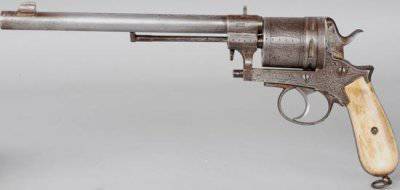 As is clear from the name of the weapon, this revolver appeared in 1870, it was this year that the designer received a patent for this weapon and immediately set up its production. Despite its dimensions, the revolver seems light enough, this feeling arises due to the fact that there is no part of the frame above the drum, that is, the drum is open on top. This design of revolvers usually significantly affects the strength of the weapon, which limits the power of the cartridges used in it. The frame itself revolver consists of two parts, one of which is assembled trigger mechanism, while the other holds the barrel and drum. In this case, both parts of the frame are connected using threaded connections. Thus, the whole structure is held together only by a screw located under the drum axis and, thanks to the drum axis itself, which is also screwed into the frame of the revolver. Ammunition that is used in this model of weapons, have a metric designation 11,25x36R. The same ammunition was also used in the Werndl carbines, a bit later the name 11,3 Gasser 1870-74 Montenegrino was assigned to them. The weight of the revolver itself, despite its apparent lightness, is almost one and a half kilograms. The length of the barrel of a revolver is equal to 235 millimeters, the revolver itself has a length of 375 millimeters. The drum holds 6 cartridges.
As is clear from the name of the weapon, this revolver appeared in 1870, it was this year that the designer received a patent for this weapon and immediately set up its production. Despite its dimensions, the revolver seems light enough, this feeling arises due to the fact that there is no part of the frame above the drum, that is, the drum is open on top. This design of revolvers usually significantly affects the strength of the weapon, which limits the power of the cartridges used in it. The frame itself revolver consists of two parts, one of which is assembled trigger mechanism, while the other holds the barrel and drum. In this case, both parts of the frame are connected using threaded connections. Thus, the whole structure is held together only by a screw located under the drum axis and, thanks to the drum axis itself, which is also screwed into the frame of the revolver. Ammunition that is used in this model of weapons, have a metric designation 11,25x36R. The same ammunition was also used in the Werndl carbines, a bit later the name 11,3 Gasser 1870-74 Montenegrino was assigned to them. The weight of the revolver itself, despite its apparent lightness, is almost one and a half kilograms. The length of the barrel of a revolver is equal to 235 millimeters, the revolver itself has a length of 375 millimeters. The drum holds 6 cartridges.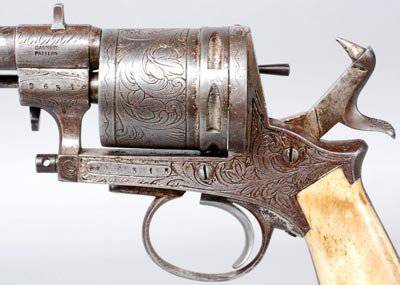 The revolver has a double-action firing mechanism. Since it is impossible to quickly remove the drum from a weapon, as well as quickly gain access to its chambers, a opening window for charging and removing the spent cartridge cases from the weapon is provided in the weapon frame. This window has a spring clip, which is made in the form of a conventional leaf spring screwed to the frame of the weapon. Thus, quick reloading is out of the question, since new ammunition is placed one in each drum chamber through the charging window. In addition, before inserting new cartridges into the chambers of the revolver's drum, they still need to be freed from the spent cartridges, which is also done alternately with an extractor located under the barrel, or rather just to the right of it. This extractor does not retract and does not fold, but is located in its fixed place constantly opposite the recharge window.
The revolver has a double-action firing mechanism. Since it is impossible to quickly remove the drum from a weapon, as well as quickly gain access to its chambers, a opening window for charging and removing the spent cartridge cases from the weapon is provided in the weapon frame. This window has a spring clip, which is made in the form of a conventional leaf spring screwed to the frame of the weapon. Thus, quick reloading is out of the question, since new ammunition is placed one in each drum chamber through the charging window. In addition, before inserting new cartridges into the chambers of the revolver's drum, they still need to be freed from the spent cartridges, which is also done alternately with an extractor located under the barrel, or rather just to the right of it. This extractor does not retract and does not fold, but is located in its fixed place constantly opposite the recharge window.An interesting point is that this revolver has a device for protection against accidental firing.
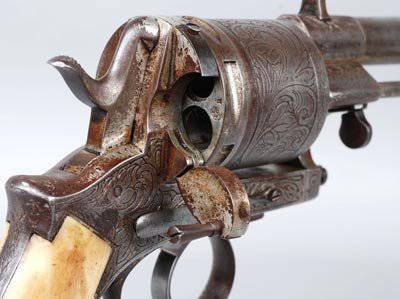 On the right side of the weapon frame there is a long lever; as it moves, a cunning mechanism came into action, which with the help of a spring-loaded pin locked the trigger of the weapon. In order to protect themselves from an accidental shot, it was enough to move the lever and slightly pull the trigger of the revolver towards us so that the locking pin could be in front of him. After that, it was possible to press the trigger until blue in the face, the shot would not follow, just as in the fall of a fairly weighty revolver on the trigger. Such a system may be called the safest, but in my opinion it would be more reasonable to associate this pin, which locks the trigger with the trigger, so that it is removed when the trigger is fully pulled.
On the right side of the weapon frame there is a long lever; as it moves, a cunning mechanism came into action, which with the help of a spring-loaded pin locked the trigger of the weapon. In order to protect themselves from an accidental shot, it was enough to move the lever and slightly pull the trigger of the revolver towards us so that the locking pin could be in front of him. After that, it was possible to press the trigger until blue in the face, the shot would not follow, just as in the fall of a fairly weighty revolver on the trigger. Such a system may be called the safest, but in my opinion it would be more reasonable to associate this pin, which locks the trigger with the trigger, so that it is removed when the trigger is fully pulled.Another interesting point in the weapon is that its sights are located only on the barrel. So, both the rear sight and the front sight are welded to the barrel of the weapon, which can even be called a plus under the condition that the revolver does not have the highest strength, at least you can aim where the barrel is looking, regardless of the backlash of the frames relative to each other.
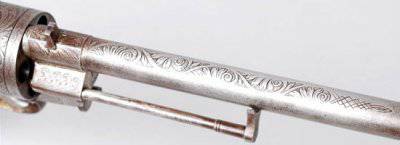 Leopold Gasser’s M1870 revolver was a really serious weapon, sufficient weight extinguished recoil when firing, a long barrel and successfully selected ammunition, allowed to conduct effective fire at sufficiently large distances for short-barreled weapons. But naturally, the revolver had flaws that overlapped all its advantages. The same large weight was quite a serious drawback when wearing, as well as size. The design of the revolver itself was not the most perfect by the standards of later types of weapons, for its own time it was considered quite normal, just like reloading on one cartridge. In order for the weapon to reduce its weight and length, two more versions of the weapon were developed, which differed from the original weapon only in the barrel length. So, there are known variants with barrels of 185 and 127 millimeters long, the length of the revolvers themselves was 325 and 267 millimeters, respectively.
Leopold Gasser’s M1870 revolver was a really serious weapon, sufficient weight extinguished recoil when firing, a long barrel and successfully selected ammunition, allowed to conduct effective fire at sufficiently large distances for short-barreled weapons. But naturally, the revolver had flaws that overlapped all its advantages. The same large weight was quite a serious drawback when wearing, as well as size. The design of the revolver itself was not the most perfect by the standards of later types of weapons, for its own time it was considered quite normal, just like reloading on one cartridge. In order for the weapon to reduce its weight and length, two more versions of the weapon were developed, which differed from the original weapon only in the barrel length. So, there are known variants with barrels of 185 and 127 millimeters long, the length of the revolvers themselves was 325 and 267 millimeters, respectively.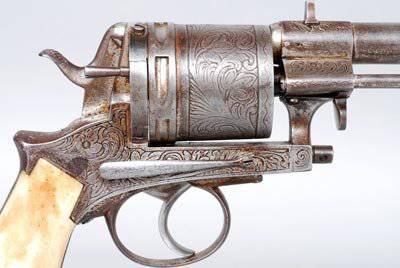 The more significant disadvantage of this weapon was that it was very expensive, the samples were often engraved, the handles were made of ivory or valuable wood, in general, the weapon was not cheap at all. But not the external beauty of the weapon filled him with a price, the fact is that almost every detail of the revolver was made using forging, which is quite difficult from the point of view of mass production. While looking at what modern blacksmiths manage to make, you stop wondering. However, these revolvers were never positioned as a mass weapon, but I think that Leopold Gasser would be glad if that were so. So, despite the fact that the revolver was called the army one, he had nothing to do with the army, except for the wealthy officers who acquired these weapons.
The more significant disadvantage of this weapon was that it was very expensive, the samples were often engraved, the handles were made of ivory or valuable wood, in general, the weapon was not cheap at all. But not the external beauty of the weapon filled him with a price, the fact is that almost every detail of the revolver was made using forging, which is quite difficult from the point of view of mass production. While looking at what modern blacksmiths manage to make, you stop wondering. However, these revolvers were never positioned as a mass weapon, but I think that Leopold Gasser would be glad if that were so. So, despite the fact that the revolver was called the army one, he had nothing to do with the army, except for the wealthy officers who acquired these weapons.The situation changed after gunsmith Leopold Gasser died in 1871. His business was inherited by his brother Johan Gasser, who turned out to be a vein, and the designer was not bad either.
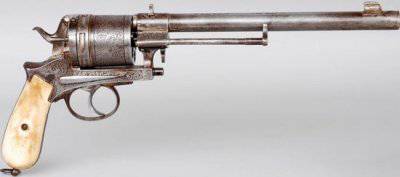 It was thanks to Johann Gasser that the M1870 revolver became quite widespread, since the designer proposed to modernize the production of weapons, replacing forging with steel casting. The weapon also lost all of its “decorations”, but the design exactly repeated its predecessor. Due to the change in production technology, it was possible to obtain weapons that are much cheaper and more affordable. Quite often, the resulting revolver is called the 1973 model of the year, although this is still the same Gasser M1870. A significant reduction in the price of weapons immediately affected its distribution, and soon the Austrian fleet was armed with a revolver, and then it appeared in the army.
It was thanks to Johann Gasser that the M1870 revolver became quite widespread, since the designer proposed to modernize the production of weapons, replacing forging with steel casting. The weapon also lost all of its “decorations”, but the design exactly repeated its predecessor. Due to the change in production technology, it was possible to obtain weapons that are much cheaper and more affordable. Quite often, the resulting revolver is called the 1973 model of the year, although this is still the same Gasser M1870. A significant reduction in the price of weapons immediately affected its distribution, and soon the Austrian fleet was armed with a revolver, and then it appeared in the army.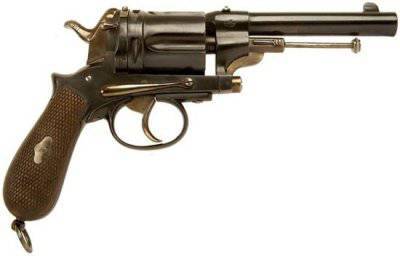 An even more interesting weapon is the Gasser M1870 / 74 revolver, also known as Montenegrin, as Montenegro is called in the Italian interpretation. There is one interesting storythat supposedly King Nicholas once loved these weapons so much that he obliged the entire male population to become the owner of this revolver. It is hard to believe in this, of course, but the tale of the ruler, who is not only not afraid, but also obliges the people to arm, is very attractive to us. If you take the reality, then really this weapon has gained a very high popularity in the area, and there were many reasons for this.
An even more interesting weapon is the Gasser M1870 / 74 revolver, also known as Montenegrin, as Montenegro is called in the Italian interpretation. There is one interesting storythat supposedly King Nicholas once loved these weapons so much that he obliged the entire male population to become the owner of this revolver. It is hard to believe in this, of course, but the tale of the ruler, who is not only not afraid, but also obliges the people to arm, is very attractive to us. If you take the reality, then really this weapon has gained a very high popularity in the area, and there were many reasons for this.As is clear from the name of the weapon, it was made on the basis of the M1870 revolver, but it was not completely identical to this revolver. First of all, the absence of an extractor that was located below the trunk on the right is evident. Now the extractor became a separate part, which was hidden in the axis of the drum and fixed with a lever that simply clamped it inside. On the one hand, this significantly improved the convenience of carrying a weapon, on the other hand, it was necessary to make some changes to the design of the axis of the drum, which, although they did not cause complaints, but significantly reduced the safety margin of the weapon. The frame of the revolver, as before, consisted of two parts, one of which was assembled with a firing mechanism of the weapon, while the other held the barrel. Now the whole construction rested on only one screw, since the frame simply wore on the axis of the drum and was not fixed with absolutely nothing. Of course, the high quality of the weapon and the maximum fit of each detail made the life of the revolver large enough, but the very essence that the design of the weapon became more fragile makes the attitude to this revolver a little worse than to the M1870 with all its flaws.
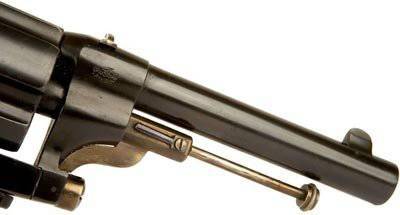 The M1870 / 74 revolver uses all the same 11,25x36R cartridges, however, the barrel length is 128 millimeters, and the length of the 255 weapon itself is millimeters. The drum began to hold 6 cartridges instead of 5, and its surface was no longer smooth. The weapon is charged through the exact same window as in the М1870 model, that is, the speed of this procedure has not increased. But the system of protection from an accidental shot has become a little more perfect. In general, everything was organized in the same way as in the previous model. That is, when the safety lever was shifted, a spring-loaded pin rested against the trigger, which, when the trigger was retracted, prevented its movement towards the cartridge cap, only in this case, when the trigger was pressed, the pin was removed. In other words, the weapon turned out to be completely safe when the trigger was dropped, and at the same time it became always ready for firing, since the revolver had a double-action firing mechanism. In addition, it was possible to safely carry a weapon with a cocked trigger, since the trigger was connected directly to the safety device, then in case of a disruption of the trigger for any reason, it would have rested against the pin, since the trigger of the weapon was not pressed, , the random shot protection mechanism was not disabled. In general, the design has become more thoughtful and easy to use.
The M1870 / 74 revolver uses all the same 11,25x36R cartridges, however, the barrel length is 128 millimeters, and the length of the 255 weapon itself is millimeters. The drum began to hold 6 cartridges instead of 5, and its surface was no longer smooth. The weapon is charged through the exact same window as in the М1870 model, that is, the speed of this procedure has not increased. But the system of protection from an accidental shot has become a little more perfect. In general, everything was organized in the same way as in the previous model. That is, when the safety lever was shifted, a spring-loaded pin rested against the trigger, which, when the trigger was retracted, prevented its movement towards the cartridge cap, only in this case, when the trigger was pressed, the pin was removed. In other words, the weapon turned out to be completely safe when the trigger was dropped, and at the same time it became always ready for firing, since the revolver had a double-action firing mechanism. In addition, it was possible to safely carry a weapon with a cocked trigger, since the trigger was connected directly to the safety device, then in case of a disruption of the trigger for any reason, it would have rested against the pin, since the trigger of the weapon was not pressed, , the random shot protection mechanism was not disabled. In general, the design has become more thoughtful and easy to use.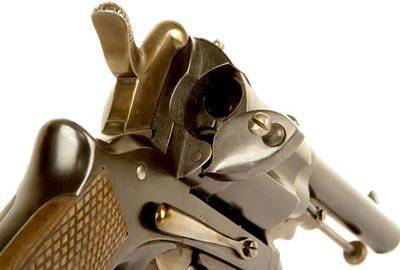 The sights of the revolver, as well as in the model M1870, remained located on the barrel of the weapon, despite the reduction of its length, and many other points in the weapon are identical to the predecessor of this weapon. True, it should also be noted here that this model of the revolver was produced not only by Gasser, but also by many other weapons companies, including very small ones, so that one can find many models differing from each other in insignificant details. The original revolvers can be identified by the mark in the form of a heart pierced by an arrow, although no one bothers anyone to do the same. You can also find revolvers from Belgium, which are usually stamped with an apple and an arrow. Given the high popularity of weapons and the number of manufacturers, it is very difficult to say exactly how many units of revolvers were produced, but the fact that this number will amount to hundreds of thousands is beyond doubt.
The sights of the revolver, as well as in the model M1870, remained located on the barrel of the weapon, despite the reduction of its length, and many other points in the weapon are identical to the predecessor of this weapon. True, it should also be noted here that this model of the revolver was produced not only by Gasser, but also by many other weapons companies, including very small ones, so that one can find many models differing from each other in insignificant details. The original revolvers can be identified by the mark in the form of a heart pierced by an arrow, although no one bothers anyone to do the same. You can also find revolvers from Belgium, which are usually stamped with an apple and an arrow. Given the high popularity of weapons and the number of manufacturers, it is very difficult to say exactly how many units of revolvers were produced, but the fact that this number will amount to hundreds of thousands is beyond doubt.In addition to the M1870 / 74 revolver model, the name Montenegrin is another revolver, also released from the walls of the Gasser company, which appeared in the 1880 year. But we will consider this weapon a bit later, for now let's get acquainted with another variation on the M1870 revolver design.
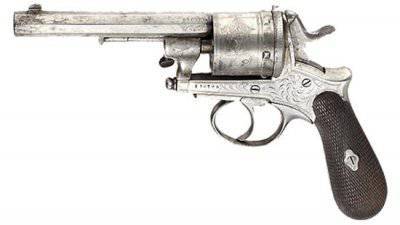 In 1876, Alfred Kropachek proposed his own version of a revolver for officers of Austria-Hungary, which was based on Leopold Gasser’s M1870 revolver. New revolver got the name Gasser-Kropachek M1876. If you look in general, then nothing has been done except for reducing the length of the barrel of the weapon, but this is only at first glance.
In 1876, Alfred Kropachek proposed his own version of a revolver for officers of Austria-Hungary, which was based on Leopold Gasser’s M1870 revolver. New revolver got the name Gasser-Kropachek M1876. If you look in general, then nothing has been done except for reducing the length of the barrel of the weapon, but this is only at first glance.First of all, the barrel length of the revolver was reduced, and the ammunition was replaced with the cartridge 9x26R. For the same reason, the length of the drum of the weapon decreased and, as a result, the overall length and weight of the revolver decreased. Thus, the length of the barrel of the Gasser-Kropachek M1876 revolver is 118 millimeters, the total length of the weapon has been reduced to 235 millimeters, and the weight has become equal to 770 grams without cartridges. The frame of the revolver consists still of two parts, in one the trigger mechanism of the weapon is mounted, in the other the barrel is fixed. In order to reduce the cost of weapons, only the front part of the frame with the barrel was changed, so the handle and the second part of the frame with the trigger mechanism remained completely identical to the M1870, so that at that time they were thinking about unifying the weapon.
Since the weapon was in its design almost all the same M1870, then it makes no sense to describe it, perhaps the only interesting point is that, in addition to the option for the army, there was also a civilian version of the weapon, which was different drum with grooves.
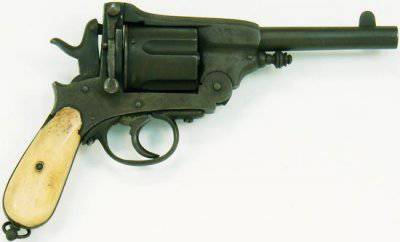 As already noted earlier, not only the 1874 revolver model of the year is known under the name Montenegrin. In 1880, the new Gasser revolver appeared. This weapon was already fundamentally different from the previous versions, since the revolver was a "turning point". The frame of the weapon consists of two parts, but they are fixed in such a way that the front part of the frame has the ability to tilt forward. Fixed part of the frame with a pin, which enters the hole of both frames and makes the structure stationary. The peculiarities of this revolver are that the locking pin is connected with a spring-loaded lever, which can be pressed without removing the hand from the handle. The possibility of tilting the front of the frame significantly accelerated the procedure for reloading the weapon, since thanks to this the shooter got access to all the cameras at once. In addition, the drum of the revolver received an extractor, which extracts all the sleeves from the drum chamber when the frame of the revolver is flushed. This is organized by means of a gear gear, fixed in the frame of a revolver and protrusions for it in the axis of the extractor. Thus, when perelamyvanii teeth gears interact with the cut in the axis of the extractor, forcing him to raise, removing the cartridge case. After that, you can simply flip the revolver and shake out the liner, and then put in their place new cartridges.
As already noted earlier, not only the 1874 revolver model of the year is known under the name Montenegrin. In 1880, the new Gasser revolver appeared. This weapon was already fundamentally different from the previous versions, since the revolver was a "turning point". The frame of the weapon consists of two parts, but they are fixed in such a way that the front part of the frame has the ability to tilt forward. Fixed part of the frame with a pin, which enters the hole of both frames and makes the structure stationary. The peculiarities of this revolver are that the locking pin is connected with a spring-loaded lever, which can be pressed without removing the hand from the handle. The possibility of tilting the front of the frame significantly accelerated the procedure for reloading the weapon, since thanks to this the shooter got access to all the cameras at once. In addition, the drum of the revolver received an extractor, which extracts all the sleeves from the drum chamber when the frame of the revolver is flushed. This is organized by means of a gear gear, fixed in the frame of a revolver and protrusions for it in the axis of the extractor. Thus, when perelamyvanii teeth gears interact with the cut in the axis of the extractor, forcing him to raise, removing the cartridge case. After that, you can simply flip the revolver and shake out the liner, and then put in their place new cartridges. 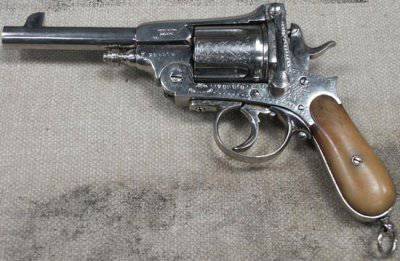 The disadvantages of the revolver design include the fact that there is a chance to touch the lever of fixing the frame of the weapon, as a result of which it can open at the most inappropriate moment, or the locking pin can move and the frame will open during the shot. However, this problem was solved literally in the first batches of weapons by changing the pin with the lever to the lock of Frankot, but the essence didn’t change, but at the same time it was more difficult to push the two levers simultaneously. In addition, the weapon used quite common for that time, but rather uncomfortable extractor of spent cartridges in the form of a plate with holes. Thus, in later models of weapons, it was already performed in the form of an “asterisk”, which ensured the independent loss of spent cartridges when opening the frame. In general, despite the fairly widespread, such a design revolver is not the most durable and can not be used in weapons that use powerful cartridges.
The disadvantages of the revolver design include the fact that there is a chance to touch the lever of fixing the frame of the weapon, as a result of which it can open at the most inappropriate moment, or the locking pin can move and the frame will open during the shot. However, this problem was solved literally in the first batches of weapons by changing the pin with the lever to the lock of Frankot, but the essence didn’t change, but at the same time it was more difficult to push the two levers simultaneously. In addition, the weapon used quite common for that time, but rather uncomfortable extractor of spent cartridges in the form of a plate with holes. Thus, in later models of weapons, it was already performed in the form of an “asterisk”, which ensured the independent loss of spent cartridges when opening the frame. In general, despite the fairly widespread, such a design revolver is not the most durable and can not be used in weapons that use powerful cartridges. 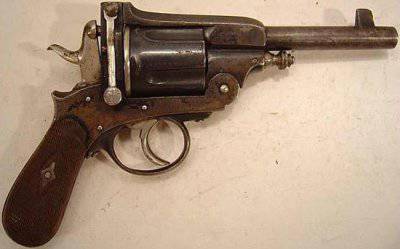 The cartridges in the weapon were used all the same - 11,25х36R, so there are no major changes in the effectiveness of the weapon, although there are no complaints just in this regard. The revolver was produced in two versions with a barrel length 133 millimeter and 235 millimeters, depends on this as the total length and weight of the weapon. The trigger mechanism of the double-action revolver, the drum holds 5 cartridges. Quite often you can find samples with engraving, and it can be really artistic, and it can look like the work of fifth-graders in the class of labor.
The cartridges in the weapon were used all the same - 11,25х36R, so there are no major changes in the effectiveness of the weapon, although there are no complaints just in this regard. The revolver was produced in two versions with a barrel length 133 millimeter and 235 millimeters, depends on this as the total length and weight of the weapon. The trigger mechanism of the double-action revolver, the drum holds 5 cartridges. Quite often you can find samples with engraving, and it can be really artistic, and it can look like the work of fifth-graders in the class of labor.The arms spread throughout Europe as if it were the only existing revolver, the number of weapons produced is unknown, since they were produced both by large weapon companies and small, little-known ones. There is a bike about this weapon, that it was almost forcibly imposed on the male population of Montenegro, just like the 74 model of the year. It seems to me that the main reason for the emergence of this story is that Nicholas, the ruler of the country at that time, was “part-time” the supplier of these revolvers to the country, naturally making a considerable profit. In addition, he also advertised this weapon, perhaps not on purpose, since in all his portraits in the time span of the popularity of these revolvers he was with this weapon.
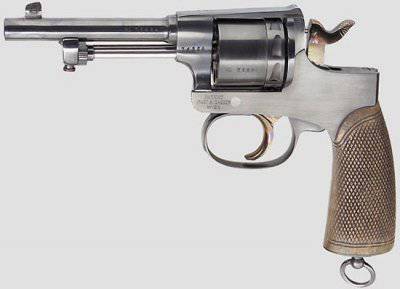 In 1898, Gasser’s designer August Rust proposed another version of the revolver, which had absolutely nothing to do with the M1870 and was fully developed by the gunsmith. In the process of developing this weapon, August Rast tried to take into account all the flaws of previous models of weapons, as a result, the 1898 revolver Rast-Gasser M1898 was already put into production, as it was distinguished by sufficiently high strength and durability compared to the previous versions of the M1870 . The revolver was not the most widespread, as it could not compete with the weapons of the Nagan brothers, however, the weapon was adopted by the army of Austria-Hungary.
In 1898, Gasser’s designer August Rust proposed another version of the revolver, which had absolutely nothing to do with the M1870 and was fully developed by the gunsmith. In the process of developing this weapon, August Rast tried to take into account all the flaws of previous models of weapons, as a result, the 1898 revolver Rast-Gasser M1898 was already put into production, as it was distinguished by sufficiently high strength and durability compared to the previous versions of the M1870 . The revolver was not the most widespread, as it could not compete with the weapons of the Nagan brothers, however, the weapon was adopted by the army of Austria-Hungary.The first disadvantage that all previous models of revolvers had were balls that were not strong enough to frame weapons that did not allow the use of powerful cartridges, and also reduced the service life of the revolver. It was this lack of weapons that Augustus Rast first of all eliminated in his revolver, making his frame whole. This significantly increased the strength of the weapon, but the designer did not dare to use powerful ammunition in his sample. The reason for the rejection of the powerful cartridges was that the designer decided to make his revolver with an increased drum capacity so that he could compete with pistols in this parameter. So, the drum of the revolver began to have an 8 chamber, which contained the cartridges with the metric designation 8x27.
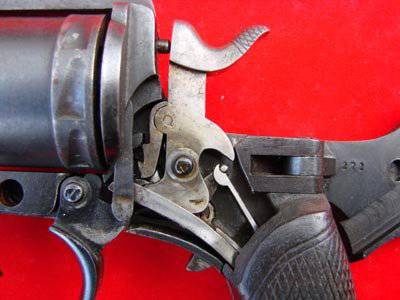 The procedure for reloading weapons through Adabi's door on the right side of the weapon, to facilitate the extraction of spent cartridges from the drum chamber, the revolver is equipped with a spring-loaded extractor, which is located under the barrel. The extractor has the ability to turn and become just to the right of the barrel, that is, in the stowed position it does not interfere with wearing, and when extracting spent cartridges it is quite convenient to operate. The surface of the drum of the weapon is smooth, without dolov, there are only small grooves for fixing the drum when firing.
The procedure for reloading weapons through Adabi's door on the right side of the weapon, to facilitate the extraction of spent cartridges from the drum chamber, the revolver is equipped with a spring-loaded extractor, which is located under the barrel. The extractor has the ability to turn and become just to the right of the barrel, that is, in the stowed position it does not interfere with wearing, and when extracting spent cartridges it is quite convenient to operate. The surface of the drum of the weapon is smooth, without dolov, there are only small grooves for fixing the drum when firing.A much more interesting point is that you can get access to the trigger mechanism of a revolver in a matter of seconds. On the left side of the frame of the revolver has a "door", opening which you can see completely all the insides of the weapon, which is quite convenient for servicing the revolver. An interesting point is also how this “door” is fixed. The fixation is carried out with the help of a pin welded to the opening part of the frame; this pin enters the hole of the frame of the weapon. On the pin itself there is a small cut-out, this cut-out includes a protrusion on a movable safety bracket, which securely fixes this element.
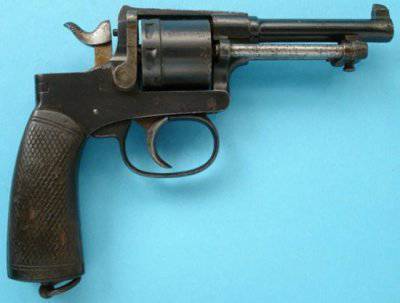 Trigger mechanism revolver double action. The trigger is separated from the spring-loaded drummer, while the trigger itself can reach the drummer only if the trigger is pressed to the end, which ensures a very high degree of safety of handling the revolver. In general, the weapon turned out to be safe, reliable, easy to maintain, the only drawback of this revolver, in my opinion, was the cartridge, but here it is necessary to take into account the age of the weapon.
Trigger mechanism revolver double action. The trigger is separated from the spring-loaded drummer, while the trigger itself can reach the drummer only if the trigger is pressed to the end, which ensures a very high degree of safety of handling the revolver. In general, the weapon turned out to be safe, reliable, easy to maintain, the only drawback of this revolver, in my opinion, was the cartridge, but here it is necessary to take into account the age of the weapon.The weight of the weapon was 980 grams without ammunition. The length of the revolver was equal to 225 millimeters with a barrel length of 116 millimeters, so you cannot call a lightweight and compact weapon. Despite fierce competition from the company of the Nagan brothers, this revolver has been in use for quite a long time. So, after the end of the First World War, a sufficiently large number of these weapons fell into Italy, where it served until the end of the Second World War. By that time, this weapon was not used anywhere else. Even after the end of the Second World War, this revolver was far from the rarest model in Italy, while in other countries even the production of 8x27 cartridges was minimized.
These are the samples of the Gasser revolvers that once filled Europe. Of course, this is not all the weapons that came out of the walls of the company, but these revolvers have become the most popular. In addition to them, there is also a huge amount of weapons intended both for the civilian market and for arming law enforcement guards, for the army and so on. Do not forget also about the revolvers, which were produced by other companies based on the designs of the Gasser weapons, they differed usually in small details. Despite the fact that the Nagan brothers made quite strong competition for these weapons, the Gasser revolvers did not lose all of their popularity, and although they had to “move over” they still remained in the market with sought-after weapons, although it is possible that in most cases it was bought weapons just because of the name gasser. If we evaluate this revolver from our time, then I personally have the phrase “European revolver” associated with Gasser’s revolvers and the Nagan brothers, and not only I have such associations. Unfortunately, revolvers in Europe have been forgotten, mostly at the moment all the production of this type of weapon is concentrated in the United States, where the revolver is considered part of the culture. Nevertheless, any of the European arms companies no, no, yes, and release a new model, which few people notice.
- Karasik Kirill
- weaponland.ru
Information